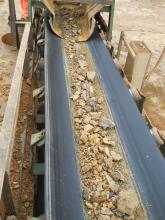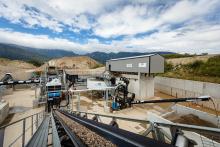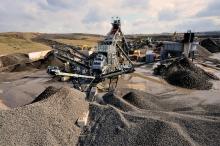
Limited access to water resources and demand for higher quality aggregates is driving demand for washing equipment in quarries. Claire Symes reports
Quality is the key to gaining the top price for aggregates in today's competitive market and washing of materials offers the opportunity to make the most of the available reserves. Space to place washing plant on site and availability of water for processing is no longer an obstacle to adding washing facilities thanks to new technology.
The latest washing equipment is also providing a boost for recycling operations and UK-based Central Demolition has said it is now reclaiming up to 95% of materials following introduction of washing to its processes. The recycling specialist said that the investment has helped it to reclaim an increased range of clean recycled aggregates, as well as other saleable products.
Central Demolition worked with Blue Machinery Scotland to develop a system to enhance both primary and secondary reclamation of recyclables from the waste streams that come into its depot at Bonnybridge in Stirlingshire.
The new system starts with a
The contaminants removed by the Powerscrub 120R logwasher, including timber, plastics and other 'lights', are floated off and dewatered on a trash screen ready for sorting and reclamation.
Sand, slurry and dirty washwater - the inevitable by-product of the washing process - is also further recycled using a Powerscreen Finesmaster 60 where a cyclone where clays, silts and slime are removed. This process helps to clean the water for reuse and also extract the sand as a saleable product.
Wider trend
While the work being carried out by Controlled Demolition is a step in the right direction, the company is not alone in its approach to trying to make the most of available resources - and this applies to quarry operators too.
"Customers are demanding better results and striving to produce higher quality products to be able to differentiate themselves from their competition," explained
"All the 'low hanging fruit' has already been processed and people are now faced with having to tackle more difficult materials - higher clay and silt contents - and this requires a washing system in order to produce material that can command a good price rather than only being suitable for low value applications such as general fill." Efficiency is also a key factor in investment in washing equipment, according to Powerscreen washing specialist Fergal McPhillips. "Customers are demanding higher efficiency from machines," he said. "They no longer want to put up with loss of revenue with inefficient machines losing sand to their water treatment systems.
"There are now proven systems that not only can reclaim aggregate which would usually have ended up in landfill, but also achieves this by using less water than any other system researched to date.
The customer would in the past have had to pay to dump the waste that washing equipment can process thus allowing them to reuse." According to Craven, improving technology plays a big part as well by redefining what it is possible to achieve with a washing plant and points to CDE's development of the M2500 as an example which has changed the way people view mobile washing.
Similarly, Powerscreen has also developed a mobile solution in its Aggwash product and McPhillips said that this is helping to deliver a solution that is easily and quickly installed. "A key feature of Aggwash is its ability to offer operators the flexibility to quickly and easily re-locate a complete wash plant operation, and eliminating the need for machinery duplication," he said.
Craven added, "Environmental legislation is also affecting the way the industry approaches things - particularly when it comes to assessing the environmental impact of an operation in terms of its use of natural resources, noise pollution, amount of waste generated and the overall carbon footprint." McPhillips agreed and added that tighter environmental regulations as well as high dumping and transportation charges are the main drivers for investment in this sector.
As an example of the reduction in material going to landfill, McPhillips points to a recent sale of an Aggwash plant to a company that specialises in laying pipes and is curreFntly trenching at the sides of roads and digging out a lot of material.
"Previously the customer would have been forced to dump this material which would have incurred a cost in transport and in dumping costs," he said. "The customer would also have had to buy sand and gravel to fill back in the area and bed down the pipes and cables. Now all the material excavated from the side of the road is put through the Aggwash and the customer can create the material he needs to bed the pipes back in."
Water resources
"The capability of the water recycling equipment means that the availability of water doesn't tend to be a major issue when it comes to a quarry considering adding a washing plant to its operations," said Craven. "With a thickener and filter press you can achieve 95% water recycling. For those washing for the first time water recycling equipment is almost always specified as they have never before had to consider the idea of ponds and when they realise the amount of space that will be required to accommodate ponds should they not specify a thickener or a press, or both, they tend to opt for the equipment that will reduce the requirement for ponds.
"With sites that already carry out washing there is a tendency for them to accept the evil that is settling ponds - they have got used to handling them so they have become almost an accepted part of their operation. Having said that, there is a growing realisation of the costs of maintaining ponds that is moving more people towards the specification of equipment which will help them reduce both the space they require and the cost of maintenance. In a lot of cases the ponds problem is accentuated by inefficient sand washing systems which send a lot of good material to the ponds - so the first step is to improve the sand washing element thus reducing the requirement to regularly clean out the ponds to recover the material that your sand washing system is losing." Use of washing also has a benefit for quarry customers too, as Craven explains, "Speaking generally in this instance, the end users of the recycled sand and aggregates are able to secure a supply from a sustainable source which tackles the issue of dwindling aggregate reserves.
"One project CDE has worked on in the Midlands region of the UK where aggregates shortages have been widely reported in recent years, the implementation of effective construction and demolition mobile washing plant is opening up the process to a wider range of quarry operators recycling systems offers the opportunity to solve this problem. By being able to provide recycled sand and aggregates to contractors in the area, they are also able to future proof themselves against a growing tendency on large civils projects for there to be a requirement to use a certain percentage of recycled material.
Mobile future
According to Craven, as with the trend that has been seen in the crushing and screening sector, mobile solutions are likely to dominate the washing market in the future.
"Mobility is without doubt one of the major factors affecting a growing uptake," he said. "The M2500 presented mobile washing to people in a format that they understood - it looks like the dry screening equipment that has been on the market for years and it ticks all the boxes for operators - minimal space required being one of the main ones.
"The other thing that has given operators comfort is the fact that it is now seen as mobile - previously what were called mobile washing plants were really mobile in name only as a result of the screening and sand washing element being separate. By being able to integrate these together people now believe they are buying a mobile plant which gives them the comfort that not only will they be able to easily move it if and when required, but also that there will be a used plant market for this equipment if they should ever need to sell it on. This is something that the dry crushing and screening market has had for a number of years and is now available in the washing market as well." Craven believes that the development of mobile washing equipment will continue in order to deliver larger capacities and production of more products. "Our current M2500 allows for the production of four products via a double deck screen and sand washing plant that allows for the production of two sands," he said. "Development on a system including a triple deck screen is underway.
"Making the water recycling equipment more mobile will undoubtedly increase uptake so there are constant efforts in this regard. The global nature of the business means that design focus is always on making transport easier."








